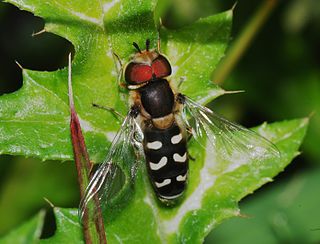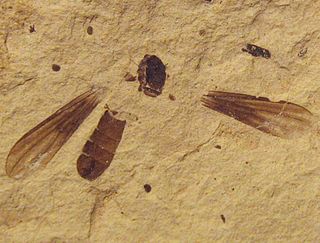| Choerades fimbriata | |
|---|---|
 | |
| Choerades fimbriata | |
| Scientific classification | |
| Kingdom: | |
| Phylum: | |
| Class: | |
| Order: | |
| Family: | |
| Genus: | |
| Species: | C. fimbriata |
| Binomial name | |
| Choerades fimbriata (Meigen, 1820) | |
Choerades fimbriata is a fly in the genus of robber flies.
| Choerades fimbriata | |
|---|---|
 | |
| Choerades fimbriata | |
| Scientific classification | |
| Kingdom: | |
| Phylum: | |
| Class: | |
| Order: | |
| Family: | |
| Genus: | |
| Species: | C. fimbriata |
| Binomial name | |
| Choerades fimbriata (Meigen, 1820) | |
Choerades fimbriata is a fly in the genus of robber flies.
The flies reach a body length of 11 to 17 millimetres. Their first antennae link is about twice as long as the following one. The tergites of the abdomen are black in colour and have yellow hairs on the sides at the back. On the first tergite the hairs are white and long. The proboscis is compressed at the sides. The area between the antennae and the beard at the front of the head is hairless.
The species is distributed from western Europe to the Caucasus and Siberia.

The Phoridae are a family of small, hump-backed flies resembling fruit flies. Phorid flies can often be identified by their escape habit of running rapidly across a surface rather than taking to the wing. This behaviour is a source of one of their alternate names, scuttle fly. Another vernacular name, coffin fly, refers to Conicera tibialis. About 4,000 species are known in 230 genera. The most well-known species is cosmopolitan Megaselia scalaris. At 0.4 mm in length, the world's smallest fly is the phorid Euryplatea nanaknihali.

Stalk-eyed flies are insects of the fly family Diopsidae. The family is distinguished from most other flies by the possession of "eyestalks": projections from the sides of the head with the eyes at the end. Some fly species from other families such as Drosophilidae, Platystomatidae, Richardiidae, and Tephritidae have similar heads, but the unique character of the Diopsidae is that their antennae are located on the stalk, rather than in the middle of the head as in all other flies.

This glossary of entomology describes terms used in the formal study of insect species by entomologists.

Scaeva pyrastri, common name the pied hoverfly, is a species of hoverfly.

Empis ciliata, the black dance fly, is a species of dance fly, in the fly family Empididae. It is included in the subgenus Euempis.

Halictus scabiosae, the great banded furrow-bee, is a species of bee in the family Halictidae, the sweat bees.

Philipomyia aprica is a species of 'horse flies' of the family Tabanidae, subfamily Tabaninae. For a further discussion of the family of insects, see entry for horse-fly.

Oxycera pardalina, the hill soldier, is a European species of soldier fly.

Psila fimetaria is a species of fly, member of the family Psilidae.
The Diptera is a very large and diverse order of mostly small to medium-sized insects. They have prominent compound eyes on a mobile head, and one pair of functional, membraneous wings, which are attached to a complex mesothorax. The second pair of wings, on the metathorax, are reduced to halteres. The order's fundamental peculiarity is its remarkable specialization in terms of wing shape and the morpho-anatomical adaptation of the thorax – features which lend particular agility to its flying forms. The filiform, stylate or aristate antennae correlate with the Nematocera, Brachycera and Cyclorrhapha taxa respectively. It displays substantial morphological uniformity in lower taxa, especially at the level of genus or species. The configuration of integumental bristles is of fundamental importance in their taxonomy, as is wing venation. It displays a complete metamorphosis, or holometabolous development. The larvae are legless, and have head capsules with mandibulate mouthparts in the Nematocera. The larvae of "higher flies" (Brachycera) are however headless and wormlike, and display only three instars. Pupae are obtect in the Nematocera, or coarcate in Brachycera.

The Cryptochetidae are a small family of tiny flies. Some twenty to thirty species are known. Generally they are metallic blue black, stoutly built, with the head broad and high and with clear wings. Like other species in the superfamily Lonchaeoidea, the Cryptochetidae have antennae with a cleft in the second segment. Unlike practically all Schizophora however, they lack an arista, or if they do have one, it is too small to distinguish with any confidence. The family name refers to this unusual distinction; "Cryptochetidae" literally means "those with hidden bristles". The adult flies also are unusual among insects in that they have only a single pair of abdominal spiracles — this is not a serious physiological challenge in such small insects.
Campsicnemus popeye is a species of carnivorous fly described in 2013. It was discovered from the Society Islands in French Polynesia. The species is named after the famous cartoon character Popeye the Sailor Man because of the enlarged tibia. The species is in fact among a group of six new species described as "Popeye flies". The specimen was collected in 2006 during an expedition to Tahiti.
Aphaenogaster praerelicta is an extinct species of ant in the subfamily Myrmicinae known from a solitary Late Oligocene to Early Miocene fossil found in Mexico. At the time of description A. praerelicta was one of three Aphaenogaster species known from Mexico.

Terellia serratulae is a species of tephritid or fruit flies in the family Tephritidae.

Metanephrocerus is an extinct genus of big-headed flies in the dipteran subfamily Protonephrocerinae, for which it is one of only two genera. The genus contains four described species, Metanephrocerus belgardeae, M. collini, M. groehni, and M. hoffeinsorum. Metanephrocerus is known from a group of Middle Eocene fossils which were found in Europe and a single early Eocene fossil from North America.

Bradoponera is an extinct genus of ant in the Formicidae subfamily Proceratiinae, and is one of four genera of the subfamily. The genus contains four described species Bradoponera electrina, Bradoponera meieri, Bradoponera similis, and Bradoponera wunderlichi. The species are known from several Middle Eocene amber fossils which were found in Europe.

Bibio hortulanus, common name marchfly, is a species of fly from the family Bibionidae.

Cyrtopogon ruficornis is a species of fly in the robber flies family. It is found in parts of Central and Southern Europe.

Choerades marginata is a species of robber fly found in Europe.

Scutigerella immaculata, commonly known as the garden symphylan or glasshouse symphylid, is a species of myriapod in the family Scutigerellidae. It may have originated in Europe but now has a cosmopolitan distribution and can be a pest of crops.
 | This article related to members of the fly family Asilidae is a stub. You can help Wikipedia by expanding it. |